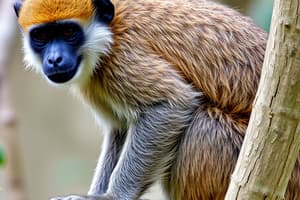Podcast
Questions and Answers
What order has bilophodont molars?
What order has bilophodont molars?
Cercopithecoidea
What order has Y-5 molars?
What order has Y-5 molars?
Hominoidea
What is the scientific method?
What is the scientific method?
The way of generating, testing, accepting, and/or rejecting hypotheses
What are the three basic steps of the scientific method?
What are the three basic steps of the scientific method?
Signup and view all the answers
What does empirical mean?
What does empirical mean?
Signup and view all the answers
What does cranial mean in humans?
What does cranial mean in humans?
Signup and view all the answers
What does caudal mean in humans?
What does caudal mean in humans?
Signup and view all the answers
What does ventral mean in anatomical terms?
What does ventral mean in anatomical terms?
Signup and view all the answers
What does dorsal mean in humans?
What does dorsal mean in humans?
Signup and view all the answers
What does medial mean?
What does medial mean?
Signup and view all the answers
What does lateral mean?
What does lateral mean?
Signup and view all the answers
What does proximal mean?
What does proximal mean?
Signup and view all the answers
What does distal mean?
What does distal mean?
Signup and view all the answers
What is the sagittal plane?
What is the sagittal plane?
Signup and view all the answers
What is the coronal plane?
What is the coronal plane?
Signup and view all the answers
What is the transverse plane?
What is the transverse plane?
Signup and view all the answers
What does mesial mean?
What does mesial mean?
Signup and view all the answers
What does distally mean?
What does distally mean?
Signup and view all the answers
What does lingual mean?
What does lingual mean?
Signup and view all the answers
What does buccal mean?
What does buccal mean?
Signup and view all the answers
What is the occlusal surface?
What is the occlusal surface?
Signup and view all the answers
What does flexion mean?
What does flexion mean?
Signup and view all the answers
What does extension mean?
What does extension mean?
Signup and view all the answers
What does abduction mean?
What does abduction mean?
Signup and view all the answers
What does adduction mean?
What does adduction mean?
Signup and view all the answers
What does rotation mean?
What does rotation mean?
Signup and view all the answers
What does pronation mean?
What does pronation mean?
Signup and view all the answers
What does supination mean?
What does supination mean?
Signup and view all the answers
What are cranial elements?
What are cranial elements?
Signup and view all the answers
What are postcranial elements?
What are postcranial elements?
Signup and view all the answers
What does phylogenetic refer to?
What does phylogenetic refer to?
Signup and view all the answers
What does phenetic refer to?
What does phenetic refer to?
Signup and view all the answers
What is the highest taxonomic level?
What is the highest taxonomic level?
Signup and view all the answers
What are lower taxonomic levels?
What are lower taxonomic levels?
Signup and view all the answers
What is a taxon?
What is a taxon?
Signup and view all the answers
Who created the system of classifying organisms?
Who created the system of classifying organisms?
Signup and view all the answers
What is the order of classification?
What is the order of classification?
Signup and view all the answers
What are primates?
What are primates?
Signup and view all the answers
What is an apomorphic trait?
What is an apomorphic trait?
Signup and view all the answers
What is a plesiomorphic trait?
What is a plesiomorphic trait?
Signup and view all the answers
What does forward-facing eyes refer to?
What does forward-facing eyes refer to?
Signup and view all the answers
What does hair represent in mammalian traits?
What does hair represent in mammalian traits?
Signup and view all the answers
List three plesiomorphic traits.
List three plesiomorphic traits.
Signup and view all the answers
List some apomorphic traits of primates.
List some apomorphic traits of primates.
Signup and view all the answers
What are the two suborders of Primates based on phylogeny?
What are the two suborders of Primates based on phylogeny?
Signup and view all the answers
What do strepsirrhines include?
What do strepsirrhines include?
Signup and view all the answers
What are traits that characterize strepsirrhines?
What are traits that characterize strepsirrhines?
Signup and view all the answers
What unique features do tarsiers possess?
What unique features do tarsiers possess?
Signup and view all the answers
How are tarsiers classified regarding anthropoids?
How are tarsiers classified regarding anthropoids?
Signup and view all the answers
What are anthropoids further divided into?
What are anthropoids further divided into?
Signup and view all the answers
What are traits of anthropoids?
What are traits of anthropoids?
Signup and view all the answers
What are Platyrrhini traits?
What are Platyrrhini traits?
Signup and view all the answers
What are Catarrhini traits?
What are Catarrhini traits?
Signup and view all the answers
What are traits of Cercopithecoidea?
What are traits of Cercopithecoidea?
Signup and view all the answers
What are the dietary adaptations of two subfamilies of Cercopithecoids?
What are the dietary adaptations of two subfamilies of Cercopithecoids?
Signup and view all the answers
What does the family name end in?
What does the family name end in?
Signup and view all the answers
What does the subfamily name end in?
What does the subfamily name end in?
Signup and view all the answers
What are traits of Colobinae?
What are traits of Colobinae?
Signup and view all the answers
What are traits of Cercopithecinae?
What are traits of Cercopithecinae?
Signup and view all the answers
What are traits of Hominoidea?
What are traits of Hominoidea?
Signup and view all the answers
What does frugivorous mean?
What does frugivorous mean?
Signup and view all the answers
What is a key dietary trait of frugivores?
What is a key dietary trait of frugivores?
Signup and view all the answers
What does folivorous mean?
What does folivorous mean?
Signup and view all the answers
Why are leaves difficult to digest?
Why are leaves difficult to digest?
Signup and view all the answers
What are secondary compounds?
What are secondary compounds?
Signup and view all the answers
What is cellulose?
What is cellulose?
Signup and view all the answers
What do folivores typically have?
What do folivores typically have?
Signup and view all the answers
What is a sacculated stomach?
What is a sacculated stomach?
Signup and view all the answers
What do some folivorous primates have?
What do some folivorous primates have?
Signup and view all the answers
What makes folivores tend to be lethargic?
What makes folivores tend to be lethargic?
Signup and view all the answers
What does gummivorous mean?
What does gummivorous mean?
Signup and view all the answers
What do some gummivorous primates possess?
What do some gummivorous primates possess?
Signup and view all the answers
What do some gummivorous primates have on their hands and feet?
What do some gummivorous primates have on their hands and feet?
Signup and view all the answers
What are cheek teeth used for?
What are cheek teeth used for?
Signup and view all the answers
What do insectivores typically have regarding teeth?
What do insectivores typically have regarding teeth?
Signup and view all the answers
What do frugivores typically have regarding teeth?
What do frugivores typically have regarding teeth?
Signup and view all the answers
What do folivores typically have regarding teeth?
What do folivores typically have regarding teeth?
Signup and view all the answers
What are anterior teeth used for?
What are anterior teeth used for?
Signup and view all the answers
What does enamel thickness affect?
What does enamel thickness affect?
Signup and view all the answers
What do species with thick enamel typically consume?
What do species with thick enamel typically consume?
Signup and view all the answers
What do species with thin molar enamel consume?
What do species with thin molar enamel consume?
Signup and view all the answers
What do other species, like insectivores, have?
What do other species, like insectivores, have?
Signup and view all the answers
What is Kay's Threshold?
What is Kay's Threshold?
Signup and view all the answers
What is a niche?
What is a niche?
Signup and view all the answers
What are niche axes?
What are niche axes?
Signup and view all the answers
What are the two components of an ecological niche?
What are the two components of an ecological niche?
Signup and view all the answers
Study Notes
Primate Classification and Dental Morphology
- Circopithecoidea: Order characterized by bilophodont molars.
- Hominoidea: Order characterized by Y-5 molars.
Scientific Method Overview
- Comprises the process of generating, testing, and evaluating hypotheses.
- Basic steps include: observing phenomena, generating hypotheses, and testing them empirically.
Anatomical Terminology
- Cranial: Toward the head.
- Caudal: Toward the tail.
- Ventral: Toward the belly; anterior in humans.
- Dorsal: Toward the back; posterior in humans.
- Medial: Toward the midline of the body.
- Lateral: Away from the midline.
- Proximal: Closer to the axial skeleton; often refers to limb bones.
- Distal: Farther from the axial skeleton.
Planes of the Body
- Sagittal Plane: Divides the body into right and left halves.
- Coronal Plane: Divides the body into anterior and posterior halves.
- Transverse Plane: Horizontal plane slicing through the body, perpendicular to sagittal and coronal planes.
Dental Terms in Primate Anatomy
- Mesial: Toward midline at the front of the mouth.
- Distal: Toward the back of each tooth row.
- Lingual: Toward the tongue;
- Buccal: Toward the cheek.
- Occlusal: The chewing surface of teeth.
Movement Terminology
- Flexion: Decreases the angle between body parts.
- Extension: Increases the angle; opposite of flexion.
- Abduction: Movement away from the midline.
- Adduction: Movement toward the midline.
- Rotation: Turning around the long axis of a body part.
- Pronation: Forearm motion turning the palm down.
- Supination: Forearm motion turning the palm up.
Taxonomic Classification
- Taxonomic Hierarchy: Kingdom, Phylum, Class, Order, Family, Genus, Species.
- Taxon: Each level of classification created by Carolus Linnaeus.
Primate Evolution and Traits
- Primate order is split into Strepsirrhini and Haplorhini (Anthropoids).
- Strepsirrhines include lemurs, lorises, and galagos; exhibit features like postorbital bars and grooming claws.
- Tarsiers have unique traits bridging strepsirrhines and anthropoids, including nocturnality.
- Anthropoids further divided into Platyrrhini (New World monkeys) and Catarrhini (Old World monkeys, apes, humans).
Dietary Adaptations in Primates
- Folivores: Primarily eat leaves, have sharp molar cusps and complex stomachs for digestion.
- Frugivores: Primarily eat fruits, possess broad, rounded molars for mashing.
- Insectivores: Target insects; generally small with sharp-cusped molars to slice exoskeletons.
- Graminivores: Primarily consume grasses, have durable molars.
- Gummivores: Eat plant exudates, often have specialized teeth for extracting gum.
Ecological Concepts
- Niche: The role of a species, including food acquisition methods and environmental interactions.
- Niche Partitioning: Similar species separate their niches to reduce competition, following the competitive exclusion principle, which states that no two species can coexist indefinitely on the same resource.
Studying That Suits You
Use AI to generate personalized quizzes and flashcards to suit your learning preferences.
Description
Explore the classification of primates with a focus on their dental morphology and anatomical terminology. This quiz covers key concepts in the scientific method and the anatomical planes of the body, providing a comprehensive understanding of primate biology. Test your knowledge and vocabulary related to this fascinating subject!




